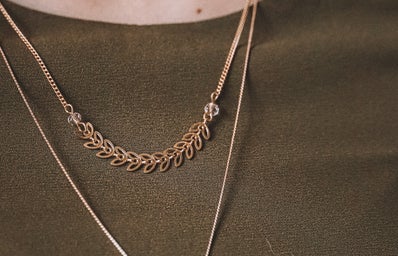With red carpet and awards season in full swing, one notable accessory seems to be missing from almost every look, necklaces. With many stylists favouring low cut necklines and pronounced collarbones as an accessory rather than the usual flashy necklaces, could this be the long-awaited revival of the heroin chic aesthetic, or rather another sign of the looming recession?
As Miranda Priestly explained in The Devil Wears Prada, the fashion industry is connected to everyone and everything, what we wear and current trends have always been a brightly lit mirror towards the current state of the world, with many economic theories like the skirt length theory emphasising the link between fashion trends and the stock market. This current lack of accessories and flashy brand names on red carpets, and in recent fashion weeks, vastly contrasts the 2020 quarantine maximalist aesthetic, when excessive jewellery and bright colours were everywhere. This change being frighteningly reminiscent of the bling era right before the 2008 recession turning into the 2009 minimalist look, which many consumers have been reverting back to. This rapid movement from the popularity of luxury fashion brands in recent years towards a more modest, timeless look is forcing fashion brands to change and officially reflect the difficult economic and social state of the world right now. Neutral minimalist brands such as The Row and Toteme are seeing a rise in popularity, and traditionally colourful brands such as Paloma Wool are having to opt for more neutral colour palettes and timeless aesthetics.
Milan’s latest menswear season has also highlighted the declining economic state of the world right now with Prada’s Raf Simons opening the conversation of ‘recession fashion’. As catwalks of the season begin to stray away from vibrant colours and extremely layered silhouettes, it seems like what has been so many peoples escape from the bleakness of the real world is becoming another reminder of it. As Prada’s latest menswear collection was revealed, we saw ballooning bomber jackets and pillow-like finishes, alongside dark striped down coats, reflecting the idea of cocooning yourself to brace the sobering darkness of the world. Meanwhile at Gucci, the fashion giant unveiled its first collection since Alessandro Michele, straying from his idea of maximalism and colour, instead toning down its aesthetic to wardrobes of staples and returning classics. Also, over at Jordan Luca, the creative directors spoke about how their new collection is all about indicating the state of the world crisis, with their models instructed to rush out seemingly in a state of fight or flight, wearing elongated suits placed unevenly and abruptly across their bodies, perhaps as a commentary on the work centric, rushed, and overtired nature of people’s lives today.
Also, the current emphasis on sustainable shopping has people searching for quality over quantity, opting for more timeless pieces, straying from fast fashion brands and microtrends, again similar to the 2009 post recession minimalist aesthetic. Could this just be due to the resurgence of old trends and vintage thrift shopping or is it a more sinister mirroring of the economic crisis and impending recession.
So, whilst the significant lack of necklaces on recent red carpet shows may just be a product of lazy styling, we cannot ignore the inextricable link between fashion, politics and the economy, and the way in which fashion has always been used as a coping mechanism. As Bill Cunningham said, ‘Fashion is the armour to survive the reality of everyday life’.


